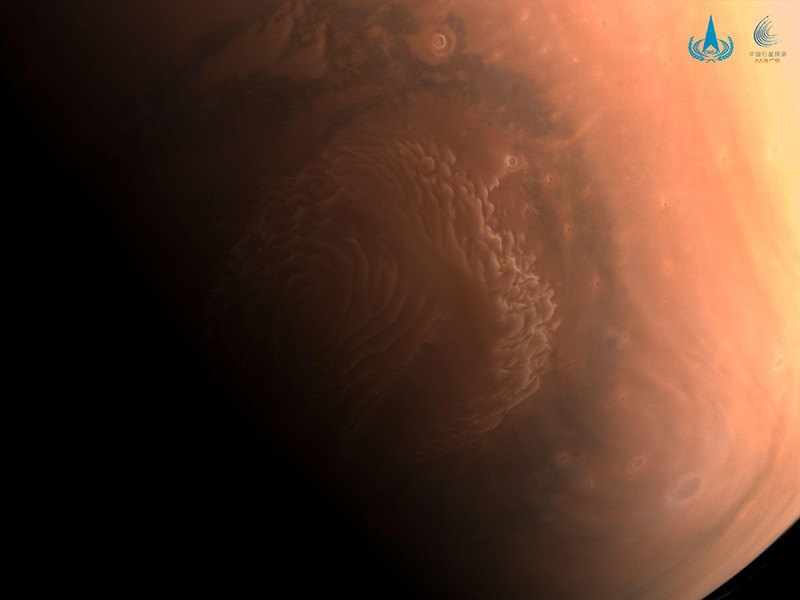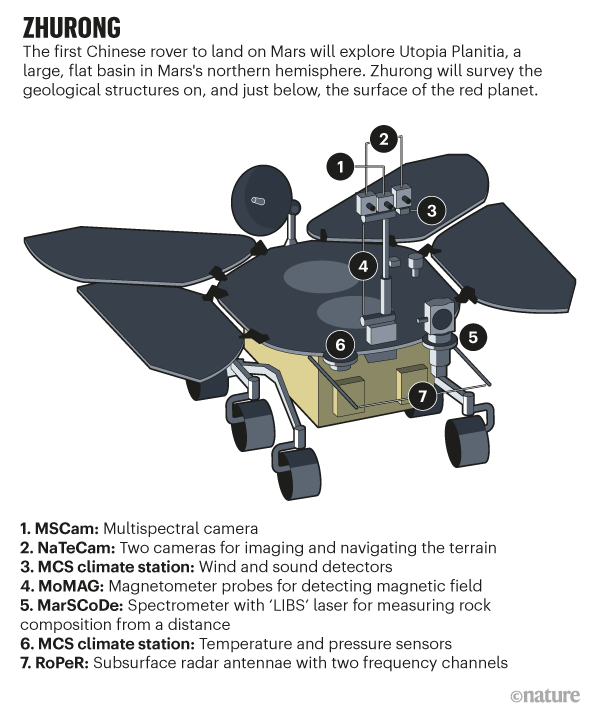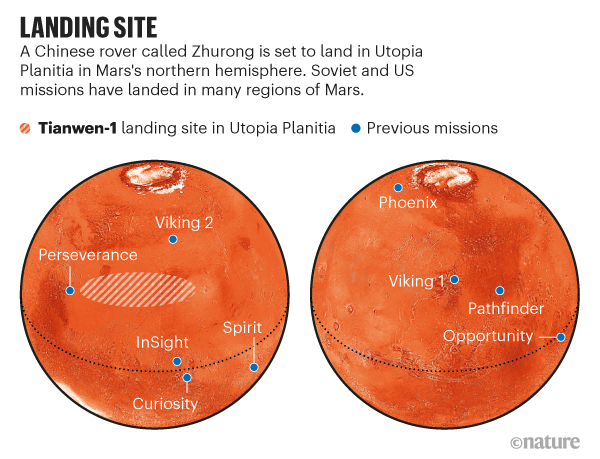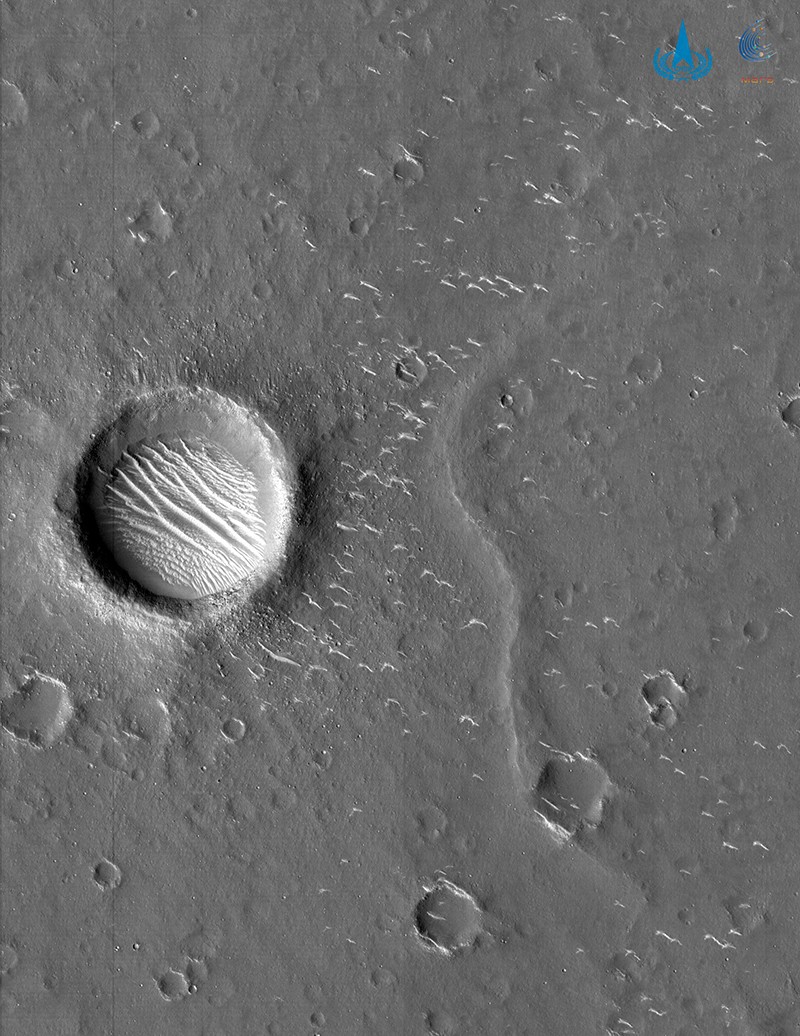
China’s Tianwen-1 spacecraft has completed the riskiest step of its ten-month mission by dropping its lander and rover — called Zhurong after a Chinese mythological god of fire — in orbit around Mars. The Tianwen-1 mission was the first to send all three elements to the planet: an orbiter, a lander, and a rover. Although the spacecraft left Earth in July 2020 and landed at Mars in February 2021, the landing was the most significant test of China’s embryonic deep-space exploration capabilities to date.
Six scientific instruments, including ground-penetrating radar, two panoramic cameras, and a magnetic field detector, are onboard the six-wheeled rover, which is about the same size as NASA’s twin Mars rovers Spirit and Opportunity. It also features a laser for zapping rocks and studying their composition, as well as a meteorological device for studying Mars’ climate and weather.

At about 4 a.m. Beijing time on May 15, the Tianwen-1 lander, with the rover affixed, segregated from the orbiter to start its plunge toward the planet’s surface after circling the Red Planet for more than three months. It hit Mars’ atmosphere at an altitude of 125 kilometers after many hours. When the rover and lander entered Mars’ atmosphere, the spacecraft went through a similar procedure to NASA’s Mars rovers’ “seven minutes of terror” when trying soft landings on Mars.
It then lurched towards the surface, protected by a heat shield, at a speed of 4.8 kilometers per second. As the spacecraft approached Mars, it dropped a massive parachute to slow its progress before braking using rocket boosters. Before landing, it hovered at 100 meters above the Martian soil and used a laser-guided system to scan the area for obstructions such as stones.
The spacecraft was shielded by a heat shield during the fiery descent, after safely parachuting down to the Utopia Planitia region, a plain inside an immense impact basin in the planet’s northern hemisphere. Tianwen-1’s landing platform fired some minor, downward-facing rocket engines to decelerate within the last few seconds of its descent, similar to NASA’s Perseverance rover landing.

The China National Space Administration (CNSA) is yet to officially confirm the successful landing, but the researchers at Macau University of Science and Technology in China and state-run China Global Television Network (CGTN) have proclaimed it on social media.
China has launched its first mission to Mars, making it only the third country after the United States and Russia to land a spacecraft on the planet. According to Roberto Orosei, a planetary scientist at the Bologna Institute of Radioastronomy in Italy, the mission “is a major leap for China since they are doing in a single go what NASA takes years to do.”
The Tianwen-1 mission was launched from Earth in July of last year, to take advantage of the two-year window when Earth and Mars are closest to each other during their orbits around the sun. On Feb. 10, the Tianwen-1 orbiter entered Martian orbit; it has been circling at a safe distance since then, planning for the landing attempt.
Zhurong weighs around 240 kilos or around 530 pounds. That’s a touch more than NASA’s Spirit and Opportunity rovers, which arrived on Mars in 2004, but only about a quarter of the mass of Curiosity and Perseverance, the two currently operating NASA Mars rovers.
The rover will roll off the lander a few days after the touchdown. Zhurong, like Spirit and Opportunity, will be powered by solar panels that may be retracted to shake off any dust that has accumulated. Nuclear batteries convert heat generated by radioactive plutonium decay into electricity for Perseverance and Curiosity.
Zhurong has now joined several other active Mars missions. The Perseverance rover, which emerged on February 18, is hundreds of kilometers away from the landing site, while NASA’s Curiosity rover has been exploring Mars since 2012. Numerous spacecraft, like the United Arab Emirates’ Hope orbiter, which landed in February, are also circling Mars. According to an astrobiologist at the Queensland University of Technology in Brisbane, Australia, David Flannery, “the more the merrier on Mars.”
According to researchers, in China’s first trip to Mars, the engineering feat of reaching there has given precedence over science, but the mission could still disclose new geological facts. They’re particularly enthused about the prospect of finding permafrost in Utopia Planitia, the northern hemisphere region of Mars where Zhurong has landed.
Zhurong will study the Red Planet with the Tianwen-1 orbiter, which will act as a data relay station for communications between mission controllers on Earth and Zhurong. The orbiter is expected to last at least one Martian year or approximately 687 Earth days.
Landing on Mars is extremely difficult, not least because scientists on Earth don’t have real-time control and must rely on pre-programmed instructions. Many missions have gone missing or have crashed on their way to their destination.
Zhurong is equipped with a variety of instruments to aid in his exploration of the Martian environment. While the rover is stationary, two cameras mounted on a mast take pictures of nearby rocks, which will be used to plan its journeys. The minerals existing in these rocks will be revealed by a multispectral camera situated between these two navigation imagers.
Zhurong, like Perseverance, possesses ground-penetrating radar. The geological processes that contributed to the development of the regions through which the rover travels will be revealed as it winds its way across the basin. According to Orosei, Zhurong could be able to identify the thin horizon that indicates any permafrost. Knowing how deep this is and what it appears like could tell information about recent climate changes on Mars, as well as the fate of ancient water that may have soaked the surface, he says.
According to Joseph Michalski, a planetary scientist at the University of Hong Kong, if the researchers are lucky, they might locate some ancient rocks that could provide a window into our own planet’s history: most of the equivalent material on Earth has been wrecked by plate tectonics.
Zhurong’s spectrometer uses laser-based technology to blast rocks to explore their makeup. It will also be the first rover to have a magnetometer on board to measure the magnetic field around it. The instrument could reveal how Mars lost its strong magnetic field, transforming the planet into a dry, cold, and uninviting environment for life.
In 2028, China plans to launch an extensive Mars sample-return mission, similar to a combined NASA-ESA sample-return mission set to launch the same year.

Meanwhile, China is embarking on its new space station, the first part of which launched in April and generated global panic last week when massive rocket debris fell uncontrollably to Earth. China and Russia are also working together on an asteroid sample return mission that will launch in 2024.
Reference:
- https://www.google.com/amp/s/www.space.com/amp/china-mars-rover-landing-success-tianwen-1-zhurong
- https://www.nature.com/articles/d41586-021-01301-7
- https://www.google.com/amp/s/www.nytimes.com/2021/05/14/science/china-mars.amp.html














